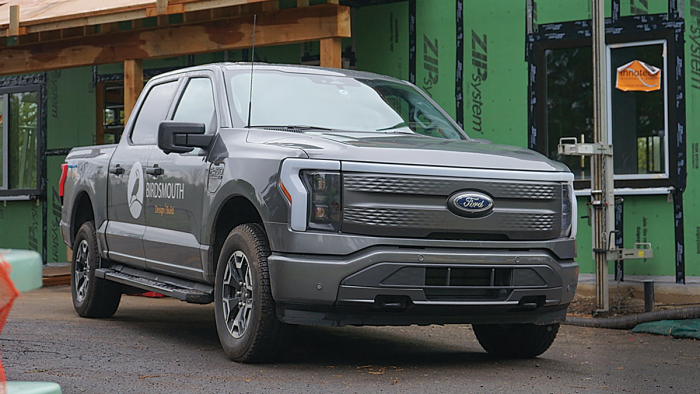A Truck That Powers the Job
As an EV, the Ford F-150 Lightning brings benefits beyond what a typical truck can offer.

Our design-build firm strives to make our operations as low-impact as our homes. So when we were in need of a new truck, we weren’t interested in purchasing a fossil fuel–powered vehicle. We opted instead for the new Ford F-150 Lightning, one of Ford’s latest offerings in the EV market. It has turned out to be a perfectly capable solution for our company, while also offering benefits beyond what a typical truck can offer.
We purchased a 2023 F-150 Lightning XLT for a base price of $68,443 and took advantage of a $7500 federal tax credit. With the savings in fuel costs (based on $4 per gal. of gas and $0.16 per kwh in Oregon), our calculations put the cost of ownership over five years at $14,257 less than that of the $65,000 gas-powered version of the F-150.
Because we’re using this electric vehicle on the job, power and range are important factors. The 98kwh battery has a rated range of 230 miles, but we have found that this varies depending on the type of driving (city miles yield much better efficiency than highway miles) and the outside temperature. Currently we are seeing anywhere from 1.6 miles per kwh to 2.9 miles per kwh, with an average of 2. Towing a fully loaded 12-ft. dump trailer led to our lowest battery efficiency; the highest included just a driver and a ladder. Other impacts to range include the number of people in the vehicle and whether climate control was used. Most of our projects are within a 40-mile radius, so range has not been a issue.
It takes eight hours to fully charge the truck from 25% with a 40A level 2 charger. Ford states that with a level 3 DC fast charger you can take a battery from 15% to 80% in 41 minutes.

One of the truck’s benefits for our team is its ability to power tools on the job site. It has ten 120v standard outlets and one 240v outlet. It was able to carpool four team members 21 miles to a job site and back while powering all the needs of a five-person framing crew. The only complaint from the team was that our 3-hp Rolair compressor would trip the 20A breaker upon recharging. We were able to use our smaller dual-tank compressor, which provided enough pressure for two framing nailers. On future projects we are even exploring foregoing temporary power on the job site.

The truck is eerily quiet, with excellent handling and minimal vibrations. But it’s knowing we can cut out fossil fuels and leverage increasing renewable power from the grid without compromising production that makes for a happy team.
–Josh Salinger, CEO of Birdsmouth Design-Build
Photos: courtesy of John Botts
From Fine Homebuilding #317
RELATED STORIES
- Step Up Your Setup
- The Future of Electric Pickups
- Build a Sliding Truck-Bed Drawer for Easy Tool Access
Fine Homebuilding Recommended Products
Fine Homebuilding receives a commission for items purchased through links on this site, including Amazon Associates and other affiliate advertising programs.

Metabo HPT Compact Cordless Miter Saw (C3607DRAQ4)

Bosch Wall Scanner (GMS 120)

Milwaukee Cordless Tablesaw (2736)

























